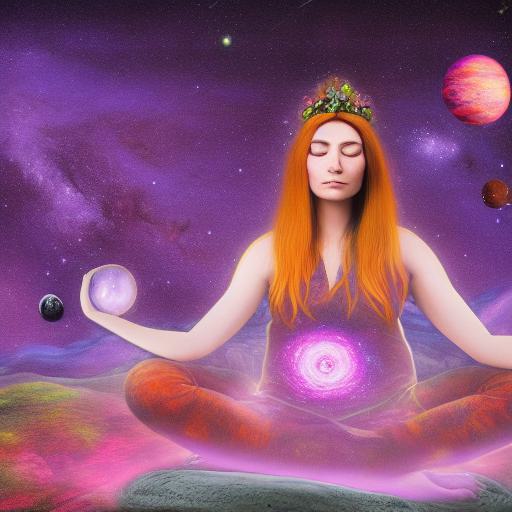How to write this prompt?
Here is a breakdown of the different components of the AI image prompt and how they influence the generated image:
- Setting: The setting of the image prompt is “space,” which sets the tone for the entire image and gives the impression of vastness, emptiness, and wonder. It also establishes the primary color scheme of the image (dark blue/black with bright stars and planets) and creates a backdrop for the woman to stand out against.
- Character: The character in the image prompt is described as a “woman in psychedelic art” who is also an “elven spirit.” This description helps to inform the overall style of the image (psychedelic/fantasy) and provides details about the woman’s appearance (pointy ears, ethereal quality). The fact that she is meditating and holding a purple flower in her hand adds a sense of calm and tranquility to the image.
- Lighting: The lighting in the image prompt is described as “accent,” with a neon lamp creating a bright and vibrant effect. This adds a sense of energy and excitement to the image and also helps to highlight the woman and the flower she is holding.
- Clothing: The woman in the image prompt is wearing a dress that is a mix of pink and purple, which helps her stand out against the space background. The description of the dress also adds to the overall psychedelic/fantasy aesthetic of the image.
- Artistic Style: The image prompt is inspired by the style of Amanda Sage, which is known for being highly detailed and textured. The use of Houdini render further enhances this level of detail and texture in the image.
By including these different components in the AI image prompt, the generator is able to create an image that is vibrant, psychedelic, and fantastical. The woman’s position on the rock, the details of the purple flower, and the way the stars and planets are arranged all contribute to the overall mood and feel of the image.
What is Houdini render and how is it used in digital art?
Houdini render is a type of rendering software that is often used in digital art to create highly detailed and textured images. It is known for its ability to handle complex geometry and lighting setups and for its flexibility in creating different visual effects. Artists can use Houdini render to create everything from photorealistic landscapes to abstract animations.
Why is the character described as an “elven spirit” and how does this influence the image?
The character being described as an “elven spirit” adds a layer of mysticism and fantasy to the image. The description of her as an “elven spirit” suggests that she is not of this world and adds to the otherworldly vibe of the image. This description also influences the way the character is depicted, with pointed ears and an ethereal quality that adds to her otherworldliness.
How to create a vibrant and textured digital image similar to the one described in the prompt?
To create a vibrant and textured digital image like the one described in the prompt, an artist would need to focus on several key elements. First, they would need to choose a bold and colorful color scheme that contrasts with the background. Next, they would need to incorporate intricate details and patterns into the image, using software like Houdini render to create a highly textured look. Finally, they would need to pay close attention to lighting and composition to create a dynamic and eye-catching image.
Do I need to have technical knowledge or programming skills to use AI art generation prompts?
No, you do not necessarily need to have technical knowledge or programming skills to use AI art generation prompts. Many AI art platforms and tools are designed to be user-friendly and accessible to artists and creators of all skill levels. These tools often come with pre-built models and templates that can be customized and adjusted based on the user’s preferences. However, having some knowledge of how the AI algorithms work and the principles of digital art can be helpful in creating high-quality and original AI-generated art.
Are there any copyright issues with using AI-generated art?
Yes, there can be copyright issues with using AI-generated art, particularly if the art is based on existing copyrighted material. In some cases, the AI-generated art may be considered a derivative work of the original material, and the original copyright owner may have the right to control how the art is used or distributed. Additionally, if the AI-generated art incorporates elements of other artists’ work without their permission, this could also lead to copyright infringement issues. It is important to be aware of these potential issues and to seek legal advice if necessary before using or distributing AI-generated art.
With the aid of design tools such as Visual Paradigm Online, incorporating AI-generated art into your designs has never been easier. Visual Paradigm Online provides a user-friendly interface and a variety of design templates and assets, enabling you to experiment with various styles and layouts until you find the perfect match for your project. In just a few clicks, you can produce stunning and visually appealing graphics that will captivate your audience.


